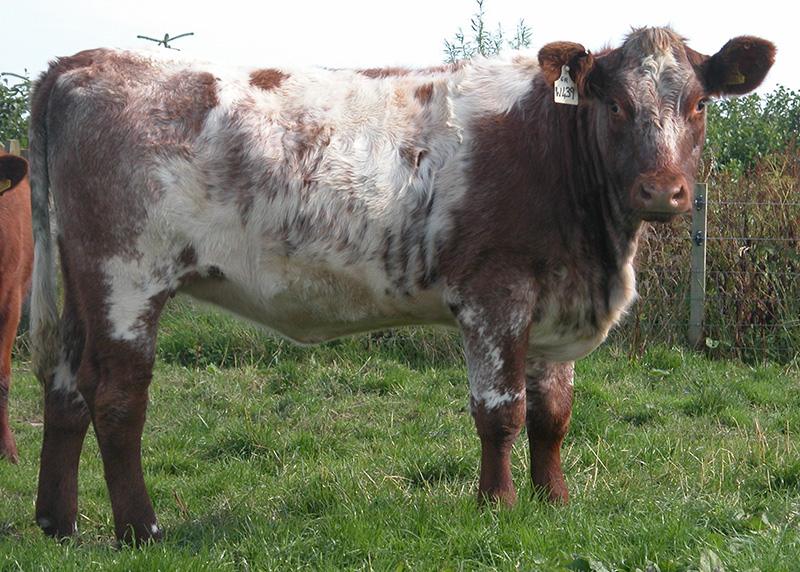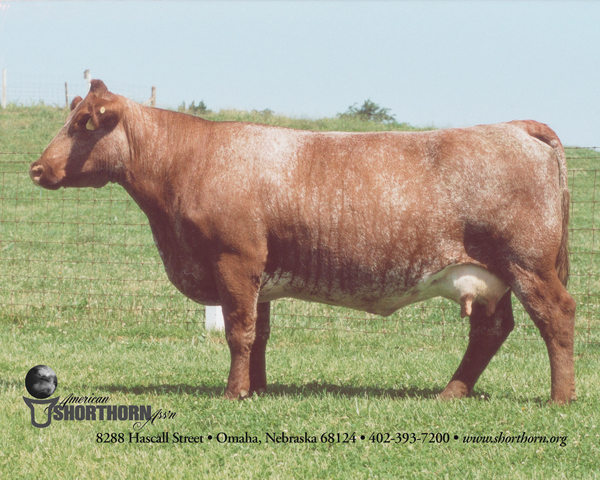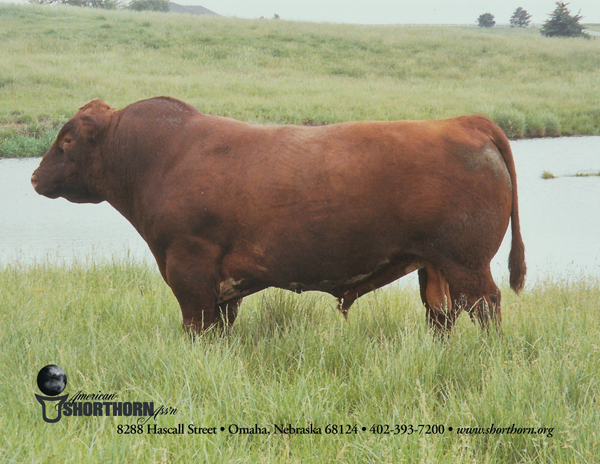Shorthorn Cattle
The Shorthorn breed of cattle originated on the northeastern coast of England in the counties of Northcumberland, Durham, York, and
Lincoln. These counties all touch the North Sea and lie between the Cheviot Hills
and the middle part of England. The first real development of the Shorthorn breed
took place in the valley of the Tees River. This river, the valley of which is so
well known in the development of the breed, lies between Durham and York counties,
and the large cattle that inhabited this fertile valley early became known as Teeswater
cattle. In addition to having acquired a reputation for producing excellent cattle,
the Tees River Valley excelled in crops, pastures, and generally high plane of agriculture.
northeastern coast of England in the counties of Northcumberland, Durham, York, and
Lincoln. These counties all touch the North Sea and lie between the Cheviot Hills
and the middle part of England. The first real development of the Shorthorn breed
took place in the valley of the Tees River. This river, the valley of which is so
well known in the development of the breed, lies between Durham and York counties,
and the large cattle that inhabited this fertile valley early became known as Teeswater
cattle. In addition to having acquired a reputation for producing excellent cattle,
the Tees River Valley excelled in crops, pastures, and generally high plane of agriculture.
Origin
Foundation Stock. North England is said to have been the home of cattle for centuries. Sinclair 1 suggests the small Celtic short-horned ox was found in England at the time of the Roman invasion and that later, cattle were introduced from northern Europe by the English, Danes, and others. By the 17th century well-known types of cattle existed in England, one of which was the "pied" stock of Lincolnshire, which was said to have been more white than colored, and the other red stock of Somerset and Gloucestershire. There existed in Holderness, a district of Yorkshire, cattle that resembled in size, shape, and color many of the cattle that were found in northern Europe at that time. At what time cattle had been introduced into England or by whom they were brought in is not definitely known. The cattle were said to have taken on flesh readily and would fatten into heavy carcasses although their flesh was coarsely grained and dark in color. Allen 2 states, "The cows were described as large milkers, and the bullocks as attaining a great weight of carcass and extraordinary production of tallow."
The Early Breeders. As early as 1580 there existed a race of superior short-horned cattle on the Yorkshire estates of the earls and dukes of Northcumberland. The coat color of these cattle varied, but among the colors found were light dun, yellow, yellowish red, deep red, red and white patched, white, and roans.
 It was not until after 1750 that accurate records of consequence were kept of the
cattle of the area or of the breeding practices that were followed. Between 1730 and
1780 many eminent breeders had distinguished themselves in their home localities for
cattle of improved type and quality. Among those who might be mentioned are Sharter,
Pickering, Stephenson, Wetherell, Maynard, Dobinson, Charge, Wright, Hutchinson, Robson,
Snowden, Waistell, Richard, Masterman, and Robertson. These men and others recorded
pedigrees in the first volume of the English Herd Book, which was not published until
1822, or after most of them were no longer active breeders.
It was not until after 1750 that accurate records of consequence were kept of the
cattle of the area or of the breeding practices that were followed. Between 1730 and
1780 many eminent breeders had distinguished themselves in their home localities for
cattle of improved type and quality. Among those who might be mentioned are Sharter,
Pickering, Stephenson, Wetherell, Maynard, Dobinson, Charge, Wright, Hutchinson, Robson,
Snowden, Waistell, Richard, Masterman, and Robertson. These men and others recorded
pedigrees in the first volume of the English Herd Book, which was not published until
1822, or after most of them were no longer active breeders.
The early breeders of Shorthorn or Teeswater cattle left a heritage with which later breeders could work. The cattle that they developed were usually of considerable size and scale, with wide back and deep, wide forequarters. Their hair and hide were soft and mellow. In addition, they were cattle that had ability at the pail and laid on fat readily under conditions of liberal feeding. It is not to be inferred that these were perfect or ideal cattle as compared to modern standards. They lacked uniformity and symmetry and were often quite prominent at their hooks and shoulder points; other faults, such as narrowness of chest, lack of spring of rib, short rumps, long legs, and unevenness of fleshing, left much to be desired. The ability of these cows to produce a good flow of milk has always been an asset to the breed, and size and scale have never been without merit. Breeders, of course, have striven through the centuries to correct some of the deficiencies that were prevalent in this Tees River stock, and at the same time to retain the most valued characteristics that the breed possessed.
Foundation of the Breed
The Contribution of Robert Bakewell. Robert Bakewell, who was born in Leicestershire in 1726, was a farmer of means who had a great influence on the Shorthorn breed although he never bred Shorthorn cattle. Prior to the time of Bakewell, farmers practiced the breeding of unrelated animals and prevented the mating of animals that were of close relationship. It remained for this animal-breeding enthusiast to demonstrate to the English farmer a revolutionary way to improve livestock. He demonstrated with his Leicester sheep and his long-horned cattle that animals of close relationship could be mated, and if rigid culling was practiced, desirable characteristics could thereby be fixed much more rapidly than by mating unrelated animals. Following the development of this breeding system by Bakewell, we find not only Shorthorn breeders but also breeders of many classes of livestock adopting his methods. Today Robert Bakewell is affectionately referred to, as the "Father of Animal Breeding" although in his time he was considered very eccentric and lacking in mental stability. This was a case of a genius in livestock breeding not being appreciated in his day.
The Colling Brothers. The Colling brothers, Charles and Robert, are often referred to as the founders of the Shorthorn breed of cattle. Other men had previously contributed to the native cattle of the area, but it remained for these two enterprising breeders to develop the first systematic breeding program. Charles Colling resided at Ketton, about four miles northeast of Darlington, in the country of Durham. Darlington had obtained considerable publicity as a market place or "fair" for cattle. Robert Colling settled at Barmpton, which was about a mile closer to the town of Darlington. It was on these two farms that the foundation of the breed was largely laid. About 1783 the Collings visited the home of Bakewell and made a study of his breeding methods.
 The system of inbreeding followed in the Colling herd is illustrated in the diagrammed
pedigree of Comet (155) in Chart 2-1. This bull was calved in 1804 and created quite
a sensation when he sold for $5,000 at public auction. The second calf sired by Favorite
(252) was steered and became known as the "Durham Ox." This beast was fitted for public
exhibition and it was shown at the reputed weight of 3,400 pounds. In those days the
cattle were exhibited but were not shown, as are our cattle at the present time. They
were toured over the country in somewhat of a sideshow exhibition. Mr. Robert Colling
reared a free-martin heifer that became famous by the name "The White Heifer that
Traveled." This nonbreeder was sired by Favorite (252) and attained a live weight
of 2,300 pounds. The publicity that was accorded the "Durham Ox" and "The White Heifer
that Traveled" did much to advertise the new breed of Shorthorn cattle that was just
being formally founded.
The system of inbreeding followed in the Colling herd is illustrated in the diagrammed
pedigree of Comet (155) in Chart 2-1. This bull was calved in 1804 and created quite
a sensation when he sold for $5,000 at public auction. The second calf sired by Favorite
(252) was steered and became known as the "Durham Ox." This beast was fitted for public
exhibition and it was shown at the reputed weight of 3,400 pounds. In those days the
cattle were exhibited but were not shown, as are our cattle at the present time. They
were toured over the country in somewhat of a sideshow exhibition. Mr. Robert Colling
reared a free-martin heifer that became famous by the name "The White Heifer that
Traveled." This nonbreeder was sired by Favorite (252) and attained a live weight
of 2,300 pounds. The publicity that was accorded the "Durham Ox" and "The White Heifer
that Traveled" did much to advertise the new breed of Shorthorn cattle that was just
being formally founded.
There is no question but that the herds of the Colling Brothers left their mark on the Shorthorn breed because nearly all Shorthorns in the United States or in Great Britain today trace to their herds in one or more lines. In their herds the bulls Foljambe (263), Favorite (252), and Comet (155) were bred and used, and they also used the great bull Hubback.
The Booth Family. The Booth family was the next to add considerable merit to the Shorthorn Breed. It is not definitely known when Thomas Booth of Killerby, in Yorkshire, began breeding purebred Shorthorn cattle, but it is known that in about 1790 he purchased what might be considered the foundation of his herd. Mr. Booth operated from the estates of Killerby and Warlaby, which were not far apart and only about 15 miles south of Darlington. Consequently he was near the Colling Brothers and drew heavily upon them for foundation bulls. Unlike Mr. Bates, his contemporary as a breeder, Mr. Booth did not go to the Colling herd for females but instead used Colling-bred bulls on rather large females that he purchased from other sources. It is said that he used bulls that were somewhat more refined than the cows to which they were bred. Apparently Mr. Booth was the first breeder to place great stress on fleshing qualities, and, in contrast to Mr. Bates, valued beef almost to the exclusion of milk. He developed an aptitude in his cattle to take on flesh, particularly during the dry period. Because of his stress on thickness of flesh and strength of back and loin, the booth family produced a line of Shorthorns of strictly beef type that had strong constitutions. Mr. Booth seemingly appreciated the Hubback and Favorite breeding more than that of other cattle in the Colling herd, and after securing the type of cattle he wanted, he inbred with much success.
In 1814 Richard Booth, Thomas Booth's son, after studying his father's method of breeding, began breeding Shorthorns. He leased a farm near Studley and later lived at Warlaby. He is said to have improved upon his father's cattle, and he particularly improved the cattle in the forequarters of bred for straighter underlines. In 1819, John Booth, the brother of Richard Booth, began breeding cattle at Killerby. After the establishment of the Royal and Yorkshire Shows in 1839, John Booth exhibited at these shows.
Bates Shorthorns. Thomas Bates was born in Northcumberland in 1775 and was of a good family. In boyhood he was sent to grammar school, spent some time taking more advanced studies, and later was given professional agricultural training. At 25 years of age he leased the extensive estates of Halton Castle but later lived at Ridley Hall and Kirklevington. He made a thorough study of the Colling herd and the cattle they produced and inspected the herds of many other breeders of the time before he decided to lay the foundation for a Shorthorn herd. In establishing his herd Mr. Bates drew very heavily upon the blood of the Collings' herd and purchased his first cattle from them in 1800 at what was then regarded as very high prices. In 1804, he purchased the cow Duchess, by Daisy Bull (186), from Charles Colling at a reported price of $500. At that time she was four years of age and in calf to Favorite (252). As will be seen from Chart 2-2, Duchess is a direct descendant of both Favorite and Hubback. This breeding was said to have greatly impressed Mr. Bates, as he claimed she was the only living direct descendant of these famous bulls. When Charles Colling affected his Ketton dispersion, Mr. Bates was on hand and purchased and granddaughter of his original Duchess cow and named her Duchess 3d. She was sired by the $5,000 but Comet (155), who was in turn sired by Favorite (252), and Favorite was also the sire of the dam of Comet, and of the cow Young Phoenix; Duchess and duchess 3d became the foundation of the very famous Duchess family, which is often thought of as synonymous with Bates breeding.
Thomas Bates stressed heavy milking qualities in his cattle, and our present Milking Shorthorns largely stem from his breeding. Thomas Bates might be regarded as the founder of the dual-purpose type of Shorthorn. James Fawcett of Scaleby Castle gave the following description of the Duchess as they were found in the herd of Thomas Bates:
The character of the Duchess at this time is that of good and handsome wide spread cows, with broad backs, projecting loins and ribs, short legs and prominent bosoms. The head was generally inclined rather to be short and wide than long and narrow, with clear eyes and muzzle, the ears rather long and hairy, the horns of considerable length and waxy. They were good milkers and had for the most part a robust healthy appearance. The color was mostly uniformly red, with in many of them, a tendency to white about the flank.
There was low fertility among the duchess females, and in 1831 the Duchess family had produced only 32 cows in 22 years. Thirty-one of these were recorded in the Herd Book. During this period of time all of the Bates herd bulls with the exception of one had been of Duchess blood.
In Speaking of the Duchess cattle, Allen 3 states:
The simple fact was that Duchess cows as a whole, had not been prolific or constant breeders, through abortions and other causes, and whenever they passed a year or two without breeding, he fed off and slaughtered them. The bulls that descended from them showed no lack of virility, and Bates still contended that the tribe had increased in their fineness of quality, were admirable feeders, and good milkers when breeding.
In 1831 Mr. Bates was searching for some females of Colling breeding and spied the bull Belvedere (1706) looking through a barn door at the farm of a Mr. Stephenson, and purchased the bull for $250. Belvedere was a yellow-roan bull of large scale with heavy shoulders and a mean disposition, but he was a bull of mellow hide. He was used freely on the Duchess females of the Bates herd, and was the sire of Duchess 34th, who was bred back to her sire to produce Duke of Northumberland (1940), the greatest breeding bull but was also shown to the Championship of England.
1 James Sinclair, History of Shorthorn Cattle, Vinton & company, Ltd., London, 1907.
2 Lewis F. Allen, Shorthorn Cattle, United Sates Department of Agriculture Report,
1878.
3 Lewis F. Allen, Shorthorn Cattle, United States Department of Agriculture Report,
1878.
Registries and Breed Associations
Ireland
The Irish Shorthorn Society
Templemore Road, Turles
Co. Tipperary, Ireland
Phone: +353 (0) 504 26806
Email: info@irishshorthorn.com
United States
American Shorthorn Association
7607 NW Prairie View Rd
Kansas City, MO 64151
Phone: (816) 599-7777
Fax: (816) 599-7782
Reference
Briggs, H.M. & D.M. Briggs. Modern Breeds of Livestock. Fourth Edition. Macmillan Publishing Co. 1980 (reprinted with permission from Dr. Briggs)
